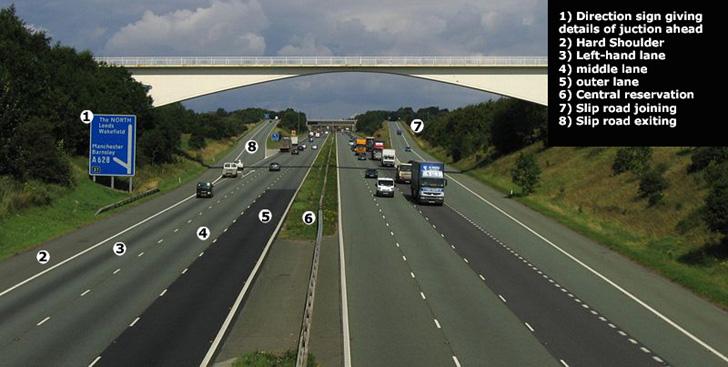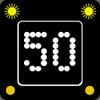For newly qualified drivers, the thought of driving on a motorway can cause dread and fear. However, motorways are the safest roads in Britain and are an excellent way of covering long distances quickly. The following guide will prepare you for the day you make your motorway debut.
Joining The Motorway
You join a motorway by using a slip road. The procedure for which is the same as when joining a dual carriageway. The main points to remember are:
You may need to look over your right shoulder to verify the position of other vehicles. Try to avoid stopping at the end of the slip road unless queuing to join other slow-moving traffic.
Once on the motorway, keep to the left-hand lane until you've had time to assess and adjust to the speed of the traffic already on the motorway.
Some slip roads continue as a dedicated lane, so you will not have to join the motorway as described above. Signs and road markings will indicate if this is the case.
Driving On The Motorway
Motorways can have two, three or even four lanes.
A two-lane motorway - keep to the left-hand lane for normal driving. Use the right-hand lane for overtaking. Once you have finished overtaking, you should move back to the left-hand lane as soon as it is safe to do so. Large goods vehicles are permitted to use either lane.
Three-lane motorway - stay in the left-hand lane unless you need to overtake slower moving traffic. To do this, you should use the middle lane. If you need to overtake several vehicles, stay in the middle lane. There is no need to weave in and out of the left-hand lane as you overtake individual vehicles.
Only use the outer lane to overtake slower moving vehicles when the left-hand and middle lanes are occupied with slower-moving traffic.
When in either the middle or outer lanes, you must be prepared to move over to the left or middle lanes to let faster-moving vehicles pass.
Large and heavy vehicles, including buses, coaches, lorries, and cars towing caravans or trailers, are not permitted to use the outer lane. So if such a vehicle approaches you from behind whilst you're in the middle lane, make sure you pull into the left-hand lane when safe to do so so that you don't block the vehicle's progress.
Changing Lanes and Overtaking on a Motorway:
When Other Vehicles Join
When driving on the motorway you will often approach entrances where other vehicles can join. When doing so:
Motorway Interchanges
These are where motorways merge or separate. They may require you to change lanes, sometimes more than once. Overhead direction signs will give you all the information you need to take the right direction.
Leaving A Motorway
You exit a motorway using a junction. These junctions are clearly marked with signs at one mile, then again at half a mile, and then countdown markers (right) at 300, 200 and 100 yards before the slip road to the exit begins.



Always try and be in the left-hand lane at around the half-mile sign, as on a dual carriage, signal left as you pass the 300-yard countdown marker.
To leave the motorway:
If you miss your intended junction - drive to the next junction, leave the motorway, and rejoin in the opposite direction, then continue to the required junction. Never try and reverse up the motorway to the slip road.
Stopping On A Motorway
You must only stop on a motorway if:
Only stop on the hard shoulder in an emergency.
If you have to slow down or stop because of traffic congestion, switch on your hazard warning lights to warn traffic behind you of the obstruction ahead. Once you are sure you have been seen, switch them off.
For information on what to do when you breakdown on a motorway.
Safe Motorway Driving
The maximum speed limit on a motorway is 70mph. However, let's be honest this speed limit is regularly exceeded. Given the speeds reached on a motorway, it is essential you try and anticipate what is happening far ahead of your vehicle. The speed means that in an emergency you will have less time to react.
Always keep a good distance between you and the vehicle in front, at least a two-second gap on a dry day. If you see brake lights ahead, ease off the accelerator. Sudden braking on a motorway can be dangerous. It can cause vehicles behind to also slam on the brakes. This causes tailbacks and even collisions.
To get a clear picture of what's coming up behind you check your mirrors regularly.
Avoid getting boxed in, with a slow-moving vehicle in front of you and another vehicle tailgating you behind. If this happens gently reduce your speed to increase the gap between you and the vehicle in front and then when safe overtake the vehicle.
Pay attention to motorway signals. These signals will tell of any hazard or danger ahead. If a signal is active on the central reservation, then the message it conveys applies to all lanes. If a signal is active above an individual lane, the message conveyed applies only to that lane.
Flashing amber lights indicate a hazard ahead. A temporary maximum speed limit may also feature on the sign as well as other warning messages. Whenever you see these warning signals, you must modify your speed and continue to comply with the instruction until you have passed a signal that is not flashing or one that gives the all-clear sign.
Red flashing lights. If red lights on the overhead signals flash above your lane and a red ‘X’ is showing, you must not go beyond the signal in that lane. If red lights flash on a signal in the central reservation or at the side of the road, you must not go beyond the signal in any lane.
Don't get tired. Statistics show that 15-20% of motorway incidents are caused by fatigue, so be prepared to stop for a break every two to three hours, and always find a safe resting place if you start to feel tired.
Reflective Studs
These will help you determine the road layout.
The Hard Shoulder
Generally speaking, you should only ever use the hard shoulder in an emergency or when you break down. However, due to traffic congestion on a limited number of motorway sections, the hard shoulder is now being used as an extra lane. You will know if you can use the hard shoulder as a normal lane if you see a speed limit sign above the hard shoulder.



Reduced visibility ahead

End of restriction

temporary maximum speed limit

Lane ahead closed

Change lanes

Do not proceed further in this lane

Leave motorway at the next exit

Temporary maximum speed limit and information message